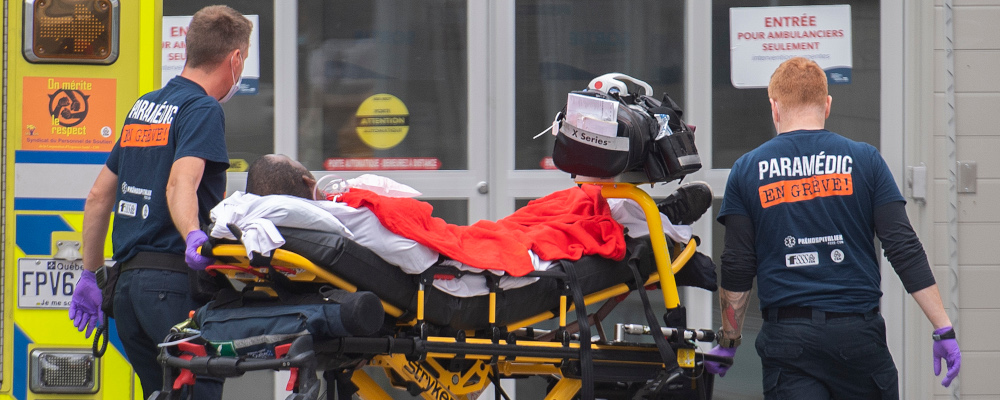The Hub’s first annual Hunter Prize for Public Policy, generously supported by the Hunter Family Foundation, focused on solving the problem of long wait times in Canada’s health-care system. A diverse group of ten finalists have been chosen from nearly 200 entries, with the finalists and winners chosen by an esteemed panel of judges, including Robert Asselin, Dr. Adam Kassam, Amanda Lang, Karen Restoule, and Trevor Tombe. The Hub is pleased to run essays from each finalist this week that lay out their plans to help solve this persistent policy problem. The winners of the first-ever Hunter Prize for Public Policy will be announced on Friday, September 29.
If there is one thing you can rely on, it’s that you will wait in an emergency department to see a doctor. While this has historically been seen as a “known evil” of the health-care system, and many initiatives have been attempted to lower ED wait times, the issue remains. I acknowledge that there is no magic pill that can cure long wait times and that any individual solution is not without its own pros and cons. However, every solution begins somewhere. While there are clearly other major health-care wait times issues being worked on simultaneously, all part of the wicked problem, this article will focus on ED wait times specifically.
We need to start to think of health care as a continuum and not isolated silos. Traditionally, each stakeholder is empowered to do what they can to help alleviate long ED wait times. This means the hospital system manages staffing, beds, and internal policies and procedures to the best of its ability. All other stakeholders are attempting to lower ED visits, but also relieve ED bottlenecks which all add to ED wait times. Concurrently, clinics and urgent care centres have been set up to give patients an alternative to the ED. Lastly, paramedic services are starting to roll out community care paramedics and support programs to decrease unnecessary ED transports AND readmissions. Each health-care partner doing what they can, on their own, with minimal coordination. This cannot continue, and a shared responsibility must be acknowledged.
The issue in many EDs is a large influx of low-priority patients taking beds needed for more emergent patients. Between the waiting room and paramedic transports, these lower acuity patients overwhelm and then bottleneck the ED. In many urban and rural hospitals, whole units are being shut down due to staffing issues. These areas would be prime places to set up a “Low-Acuity Paramedic Pod” (LAP-Pod). This would be an area in the hospital staffed with paramedics specifically tasked with taking appropriate EMS patients out of the ED stream, while at the same time helping to ameliorate EMS offload delays. Repurposing these unused spaces for the LAP-Pod will immediately open up beds, negating the need to build as many new ones, thus keeping the startup costs to this proposal minimal.
The LAP-Pod is novel in that it can help keep stable but non-ambulatory patients from entering the ED stream. It would run parallel to traditional Rapid Assessment Zone (RAZ) tracts that most often accept ambulatory patients. At the point of discharge, this patient cohort could be enrolled in community care paramedic programs to reduce readmissions as well. Importantly, as patients on EMS stretchers are diverted to the LAP-Pod, no longer needing an ED bed, waiting room times will decrease.
Paramedics are an untapped resource that can help solve the issue of long ED wait times. Paramedicine is a growing field and gone are the days of the “you call, we haul” mentality of old-school EMS. Paramedic education has evolved to produce a pre-hospital clinician, compared to the technicians of the past. Paramedics have also been rated as one of the most trusted and respected professions. In addition to centering paramedics at its core, this proposal also would enlist physician assistants (PAs) (an underutilized health-care provider in Ontario) to run the clinic together, leveraging both skill sets. This will further begin to dissolve the aforementioned health-care silos and fill in a gap in the system.
Paramedics and PAs have extensive patient care skills as it stands, but even slight augmentations to their traditional scope of practice would be cost-effective with little to no legislative changes. There are multiple health-care initiative grants currently being offered by the federal and provincial governments that could be tapped. Funding from such programs as pay-for-results (P4R), and federal health-care grants could be utilized to fund this program. Furthermore, using these two particular health-care professionals means that co-funding could come from both EMS and hospital budgets, thus reducing the burden on any one stakeholder.

A 2022 report from the OMA recommended the creation of “ambulatory centres” to free up hospital beds for acute patients and reduce wait times. The LAP-Pod model would serve similar low-acuity patient cohorts, further freeing up ED space and leading to reduced wait times. The Uphill Health site recommended increasing early and safe discharges through continued follow-up to reduce readmission (which over time will reduce overall ED wait lists). By leveraging the work of community-based paramedic programs and teams the LAP-Pod would ensure a “safe discharge” and follow-up for its patients, thus reducing readmission.
The LAP-Pod has been designed to help ED wait times in multiple ways, thus improving its effectiveness. This policy proposal would help decrease paramedic offload delay (OLD), which is when EMS crews are stuck at the hospital waiting for an ED bed. OLDs account for approximately 58,000 hours per year of paramedic time according to sources. There is also a hidden cost to these delays above just wait times. In a report from CUPE, it was noted that offload delays translated to a combined $19.5M in extra health-care spending. A source in a Toronto Sun article advocated for paramedics to “double up” on patients in their care while on OLD, and one from a CBC article noted that offload delays have gotten 12 times longer in 2022. By diverting some patients as detailed in this proposal, many of these hours can be reduced. When considering the extra value-added outcome of this proposal, it becomes even more worthwhile to pursue.
While not addressing all of the causes of long ED wait times, this proposal would certainly mitigate a significant portion of the problem. By combining the expertise of paramedics and PAs with the underutilized resources of the hospital, this proposal maximizes the success and minimizes the cost of reducing ED wait times. In addition to addressing long ED wait times, the LAP-Pod also helps to increase ambulance availability. These two wait times add to the wicked problem itself, and work on both is a value-added benefit to this proposal. The LAP-Pod, staffed by paramedics, is designed to reduce ED wait times from a variety of vantage points. Any solution to this, or other problems, would benefit from the experience, resourcefulness, and dedication that paramedics bring to the health-care field.
Read the policy paper:




